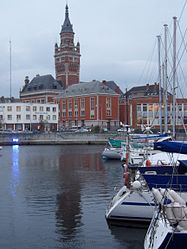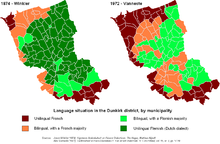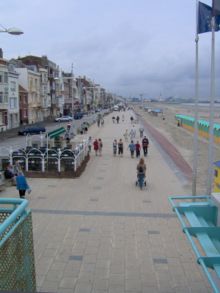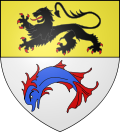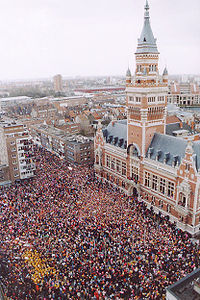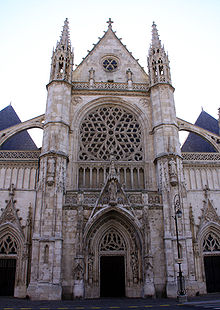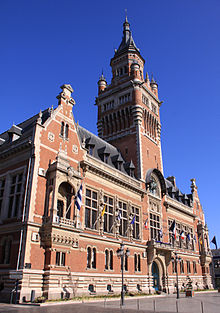- Dunkirk
-
For other uses of Dunkirk or Dunkerque, see Dunkirk (disambiguation).
Dunkirk
DunkerqueAdministration Country France Region Nord-Pas-de-Calais Department Nord Arrondissement Dunkerque Intercommunality Dunkerque grand littoral Mayor Michel Delebarre
(2008–2014)Statistics Elevation 0–17 m (0–56 ft)
(avg. 4 m/13 ft)Land area1 37.34 km2 (14.42 sq mi) Population2 70,850 (1999) - Density 1,897 /km2 (4,910 /sq mi) INSEE/Postal code 59183/ 59140, 59240, 59640 1 French Land Register data, which excludes lakes, ponds, glaciers > 1 km² (0.386 sq mi or 247 acres) and river estuaries. 2 Population without double counting: residents of multiple communes (e.g., students and military personnel) only counted once. Coordinates: 51°02′18″N 2°22′39″E / 51.038333°N 2.377500°E
Dunkirk (French: Dunkerque, pronounced: [dœ̃kɛʁk]; Dutch: Duinkerke(n) [ˈdœynkɛrkə(n)] (
 listen); Flemish: [ˈdyŋkarkə] (
listen); Flemish: [ˈdyŋkarkə] ( listen)) is a commune in the Nord department in northern France. It lies 10 kilometres (6.2 mi) from the Belgian border. The population of the city (commune) at the 1999 census was 70,850 inhabitants (71,300 inhabitants as per February 2004 estimates). The population of the metropolitan area was 265,974 inhabitants as per the 1999 census.
listen)) is a commune in the Nord department in northern France. It lies 10 kilometres (6.2 mi) from the Belgian border. The population of the city (commune) at the 1999 census was 70,850 inhabitants (71,300 inhabitants as per February 2004 estimates). The population of the metropolitan area was 265,974 inhabitants as per the 1999 census.Contents
Name and languages
The name of Dunkirk derives from West Flemish "dun(e)" (dune) and "kerke" (church). Until the middle of the 20th century the city was situated in the French Flemish area; today the local Flemish dialect, a variety of the Dutch language, can still be found but has been largely replaced by French.
History
Middle Ages
Dunkirk was first mentioned in 1067 as Dunkirk (Dutch: “Church of the Dune” or "Dune Church").[citation needed]
Privateer base
Main article: DunkirkersThe area was much disputed between Spain, the Netherlands, England and France.
At the beginning of the Eighty Years' War, Dunkirk was briefly in the hands of the Dutch rebels, from 1577. Spanish forces under the Duke of Parma re-established Spanish rule in 1583 and it became a base for the notorious Dunkirkers.
The Dunkirkers briefly lost their home port when the city was conquered by the French in 1646 but Spanish forces recaptured the city in 1652.
In 1658, as a result of the long war between France and Spain, it was captured by Franco-English forces. It was awarded to England in the peace the following year as agreed in the Franco-English alliance against Spain.
It came under French rule when Charles II of England sold it to France for £320,000[1] on 17 October 1662.
During the reign of Louis XIV, a large number of commerce raiders once again made their base at Dunkirk. Jean Bart was the most famous. The Man in the Iron Mask was arrested at Dunkirk.
The 18th century Swedish privateers and pirates Lars Gathenhielm and his wife and partner Ingela Hammar, are known to have sold their ill-gotten gains in Dunkirk.
The 1763 "Treaty of Paris" between France and Great Britain included a clause restricting French rights to fortify Dunkirk, to allay British fears of it being used as an invasion base.
Dunkirk in World War II
Main articles: Battle of Dunkirk, Dunkirk evacuation, and Siege of Dunkirk (1944)In May 1940, during the Battle of France, the British Expeditionary Force in France aiding the French, was cut off from the rest of the French Army by the German advance. Encircled by the Germans they retreated to the area around the port of Dunkirk. The German land forces could have easily destroyed the British Expeditionary Force, especially when many of the British troops, in their haste to withdraw, had left behind their heavy equipment. For years, it was assumed that Adolf Hitler ordered the German Army to stop the attack, favouring bombardment by the Luftwaffe. However, according to the Official War Diary of Army Group A, its commander, Generaloberst Gerd von Rundstedt, ordered the halt. Hitler merely validated the order several hours after the fact. This lull in the action gave the British a few days to evacuate by sea. Winston Churchill ordered any ship or boat available, large or small, to pick up the stranded soldiers, and 338,226 men (including 123,000 French soldiers) were evacuated – the miracle of Dunkirk, as Churchill called it. It took over 900 vessels to evacuate the Allied forces. More than 40,000 vehicles as well as massive amounts of other military equipment and supplies were left behind; their value being less than that of trained fighting men. The British evacuation of Dunkirk through the English Channel was codenamed Operation Dynamo. 40,000 Allied soldiers (some who carried on fighting after the official evacuation) were captured or forced to make their own way home through a variety of routes including via neutral Spain.
The city was again contested in 1944, and the 2nd Canadian Infantry Division attempted to liberate the city in September, as Allied forces surged northeast after their victory in the Battle of Normandy. However, German forces refused to relinquish their control of the city, which had been converted into a fortress, and the garrison there was "masked" by Allied troops, notably 1st Czechoslovak Armoured Brigade. The fortress under command of German Admiral Friedrich Frisius eventually unconditionally surrendered to the commander of the Czechoslovak forces, Brigade General Alois Liška, on 9 May 1945.[2]
During the German occupation, Dunkirk was largely destroyed by Allied bombings; the artillery siege of Dunkirk was directed on the final day of the war by pilots from No. 652 Squadron RAF, and No. 665 Squadron RCAF.[citation needed]
Postwar Dunkirk
On 14 December 2002, the Norwegian auto carrier Tricolor collided with the Bahamian-registered Kariba and sank off Dunkirk Harbour, causing a hazard to navigation in the English Channel.
Heraldry
The arms of Dunkirk are blazoned :
Per fess Or and argent, a lion passant sable armed and langued gules, and a dolphin naiant azure crested, barbed, finned and tailed gules.Administration
The commune has grown substantially by absorbing several neighbouring communes:
- 1970: Merger with Malo-les-Bains (which had been created by being detached from Dunkirk in 1881)
- 1972: Fusion with Petite-Synthe and Rosendaël (the latter had been created by being detached from Téteghem in 1856)
- 1980: Fusion-association with Mardyck (which became an associated commune, with a population of 372 in 1999)
- 1980: A large part of Petite-Synthe is detached from Dunkirk and included into Grande-Synthe
- 2003: Project of fusion with Saint-Pol-sur-Mer (commune created by its territory being detached from Petite-Synthe in 1877). On 19 December 2003, the municipal councils of Dunkirk and Saint-Pol-sur-Mer decided in favour of a fusion-association, which would create a new entity with a population of 94,187. The prefect requested a referendum, although this procedure was not mandatory (it became mandatory on 1 January 2005). The referendum took place on 5 December 2004, actually covering three communes: Dunkerque, Saint-Pol-sur-Mer and Fort-Mardyck. Although the yes won with 54 % of the votes, it did not gather 25% of the potential electorate, as required by the law. The prefect rejected the fusion proposal as a consequence.
Economy
Dunkirk has the third-largest harbour in France, after those of Le Havre and Marseilles. As an industrial city it depends heavily on the steel, food processing, oil-refining, ship-building and chemical industries.
Cuisine
The cuisine of Dunkirk is closely related to Flemish cuisine, perhaps one of the best known dishes is Coq à la bière, which is chicken in a creamy beer sauce.
The prototype metre
In June 1792 the French astronomers Jean Baptiste Joseph Delambre and Pierre François André Méchain set out to measure the meridian arc distance from Dunkirk to Barcelona, two cities lying on approximately the same longitude as each other and also the longitude through Paris. The belfry was chosen as the reference point in Dunkirk.
Using this measurement and the latitudes of the two cities they could calculate the distance between the North Pole and the Equator in classical French units of length and hence produce the first prototype metre which was defined as being one ten millionth of that distance.[3] The definitive metre bar, manufactured from platinum, was presented to the French legislative assembly on 22 June 1799.
Tourist attractions
- The Musée Portuaire displays exhibits of images about the history and presence of the port.
- The Musée des Beaux-Arts has a large collection of Flemish, Italian and French paintings and sculptures.
- The Carnival of Dunkirk
Transport
Dunkirk has a ferry connection with Dover, England. The Gare de Dunkerque railway station offers connections to Calais, Lille, Arras and Paris, and several regional destinations.
Sports
- USL Dunkerque, French football club, currently playing in the CFA.
- The Quatre Jours de Dunkerque (or Four Days of Dunkirk) is an important elite professional road bicycle racing event.
- Stage 2 of the 2007 Tour de France departed from Dunkirk.
Notable residents
- François Rozenthal, ice hockey player
- Maurice Rozenthal, ice hockey player
- Djoumin Sangare, footballer
- Tancrède Vallerey, writer
International relations
Twin towns — Sister cities
Dunkirk maintains Sister City relationships with the following cities:
 Krefeld, Germany since 15 June 1974
Krefeld, Germany since 15 June 1974 Middlesbrough, United Kingdom since April 12, 1976
Middlesbrough, United Kingdom since April 12, 1976 Gaza, Palestinian Authority
Gaza, Palestinian Authority Riga, Latvia since 1960
Riga, Latvia since 1960 Rostock, Germany since 1960
Rostock, Germany since 1960 Vitória, Brazil since unknown date
Vitória, Brazil since unknown date Corumbá, Brazil since unknown date
Corumbá, Brazil since unknown date Ramat HaSharon, Israel since unknown date
Ramat HaSharon, Israel since unknown date
Dunkirk has co-operation agreements with:
 Dartford district, United Kingdom since March 1988
Dartford district, United Kingdom since March 1988 Thanet district, United Kingdom since June 18, 1993
Thanet district, United Kingdom since June 18, 1993
See also
References
Notes
- ^ "Correspondence and papers of the first Duke of Ormonde, chiefly on Irish and English public affairs: ref. MS. Carte 218, fol(s). 5 – date: 26 December 1662" (Description of contents of carte papers). Oxford University, Bodleian Library, Special Collections and Western Manuscripts: Carte Papers. 2006. http://www.a2a.org.uk/search/records.asp?cat=161-msscarte_15&cid=2-3. Retrieved 17 October 2007.
- ^ (Czech) Czech army page
- ^ Adler, Ken (2002). The measure of all things – The seven year odyssey that transformed the world. Abacus. ISBN 0-349-11507-9.
External links
Categories:- Dunkirk
- Communes of Nord
- Subprefectures in France
- Port cities and towns in France
Wikimedia Foundation. 2010.

